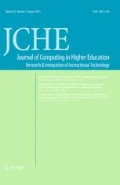Abstract
THE KNOWLEDGE ENGINEERING PROCESS, whereby a knowledge engineer works closely with a domain expert to build an expert system, is known to improve both the knowledge engineer’s and the expert’s understanding of the domain. Moreover, building an expert system is a lot like constructing a scientific theory: both activities result in the creation of an explanatory or problem-solving model of some particular domain. Mindful of this, an attempt was made to exploit the pedagogical potential of the knowledge engineering process by using it as a means of “teaching” a group of junior high school students how to do botanical classification. Serving as knowledge engineers, the students developed an expert advisory system capable of identifying tree specimens from descriptions of their gross morphology. Our observations indicated that the students not only mastered the target knowledge, but also enjoyed the opportunity to take a somewhat different approach to this standard junior high school subject. The apparent success of this experiment supports the claim that the knowledge engineering process can serve as an innovative model for science education. The model encourages a more creative, constructivist approach to teaching certain science concepts and skills, while at the same time fostering the improvement of logic, communication and independent learning skills.
Similar content being viewed by others
References
Bahill, A.T. & Ferrell, W.R. (1986). Teaching an introductory expert system course.IEEE Expert, 1(4), 59–63.
Barr, A. & Feigenbaum, E.A. (1982).The Handbook of Artificial Intelligence, Volume 2. Los Altos, CA: William Kaufman, Inc.
Brown, J.S., Burton, R. & Clancey, W. (1984). Applications of artificial intelligence to training and education.AAAI Conference Tutoring Program.
Clancey, W.J. (1985). Heuristic classification.Artificial Intelligence, 27, 289–345.
Clancey, W.J. (1988). The knowledge engineer as student: metacognitive bases for asking good questions. In H. Mandl & A. Lesgold (Eds.),Learning Issues for Intelligent Tutoring Systems. pp. 80–112. New York: Springer-Verlag.
Clement, J. (1989). Learning via model construction and criticism. In G. Glover, R. Ronning & C. Reynolds. (Eds.),Handbook of Creativity: Assessment, Theory & Research, pp. 341–381. New York: Plenum.
Cohen, P. & Howe, A. (1988). How evaluation guides AI research.AI Magazine, 9(4), pp. 35–44.
Ferrara, J., Prater, M. & Baer, R. (1987). Using an expert system for complex conceptual training.Educational Technology, 27(5), 43–46.
Feigenbaum, E.A. (1977). The art of artificial intelligence: Themes and case studies in knowledge engineering,IJCAI, 5, 1014–1029.
Harmon, Paul. (1986). Expert systems tools. In Harmon (Ed.)Expert System Strategies, 2(11), 1986.
Hayes-Roth, F., Waterman, D.A. & Lenat, D.B. (1983).Building Expert Systems. Reading, MA: Addison-Wesley Publishing Co.
Hoffman, R.R. (1987). The problem of extracting the knowledge of experts from the perspective of experimental psychology.AI Magazine, 8(2), pp. 53–67.
Prerau, D.A. (1987), Knowledge acquisition in the development of a large expert system.AI Magazine, 8(2), pp. 43–51.
Sigma Xi. (1989). An exploration of the nature and quality of undergraduate education in science, mathematics and engineering: A report of the national advisory group of Sigma Xi, the scientific research society. New Haven, CT: Sigma Xi.
Smith, K.A., Starfield, A.M. & MacNeal, R. (1985). Constructing knowledge bases: a methodology for learning to synthesize.Proceedings of the 1985 ASEE and IEEE Frontiers in Education Conference.
Starfield, A.M., Butala, K.L., England, M.M., & Smith, K.A. (1983). Mastering engineering concepts by building an expert system.Engineering Education, 104–107.
Trollip, S.R. & Lippert, R.C. (1987). Constructing knowledge bases: a promising instructional tool.Journal of Computer-Based Instruction, 14(2), 44–48.
Warman, D. & Modesitt, K.L. (1989). Learning in an introductory expert systems course.IEEE Expert, 4(1), pp. 45–59.
Woolf, B. et al. (1986). Teaching a complex industrial process.Proceedings of AAAI. Philadelphia, PA.
Woolf, B. & Cunningham, P. (1987). Multiple knowledge sources in intelligent teaching systems.IEEE Expert, 2(2), pp. 41–54.
Author information
Authors and Affiliations
Rights and permissions
About this article
Cite this article
Morelli, R. The student as knowledge engineer: A constructivist model for science education. J. Comput. High. Educ. 2, 78–102 (1990). https://doi.org/10.1007/BF02941583
Issue Date:
DOI: https://doi.org/10.1007/BF02941583




